Day 3-Recording the Samoan Kids
May 10, 2001
After dropping exhausted into bed just after 10 PM last night, I slept soundly until I awoke and looked at the clock. 1:30 AM.
I go back to sleep and wake again at 3:30 AM. Then back to sleep.
Awake again. I hear the roosters outside. No alarm yet though. The clock says it's 5:30 AM. After laying awake for 30 mintues, I decide to give up, so I get up and write. My body may be in Samoa, but my clock is still set for Nashville. Here are some things that I learned about Samoa yesterday.
-They don't grow macadamia nuts in Samoa. That's Hawaii.
-Joe Amosa, our host, is not only the pastor of the Iva Assembly of God but also a local celebrity and a TV star. His weekly show, recorded at "TV Graceland West," features interviews with local religious leaders. He is well known all over the islands and is stopped by people everywhere we go. He speaks perfect English because he went to school in Missouri for years before returning to Samoa. He understand Americans. His village, Iva, and church are on the big island of Savaii, where we will go tomorrow.
-There are two TV stations in Samoa. GBN, which carries Christian programming, and Samoan TV, which is the national TV station and only broadcasts during the day.
-The island of Upolu, where we are now, actually has TWO international airports, which seems strange to me for a country so small as Samoa. The smaller international airport is here in Apia and has a gravel runway, hosting flights to American Samoa. It IS a different country, so it is an international flight.
-Rugby is the favorite sport of Samoans, although volleyball is a close second. On several mornings, we see school children playing rugby as early as 6:30 in the morning before school.
-There are lots of geckos in Samoa. I find one in my bathroom this morning.

It's 9:30 AM and I just got back from a walk along the sea wall that runs along the waterfront here in Apia. We all meet for breakfast at the hotel restaurant, a large high-ceiling structure that has no outside walls. As we sit in the open air structure, I ask Joe about the weather in Samoa. "Is there ever a season when things are NOT green, like our American fall or winter? Is there a hot season and a cold season, or at least a LESS hot season?"
"Samoa has two seasons," answers Joe. "The rainy season and the dry season." He explains to me that this is the end of the rainy season, which extends from November to March. The temperature changes maybe 5šCelsius from the coolest to the hottest times. No spring, no fall, no winter. Just 75šF to 95šF year round. In some ways that seems nice. Someone in our party comments that it might get boring. Life without four seasons? That would take some adjusting for sure.
This is the other thing that confounds me. "With all the tropical storms I assume you have, how can your homes and other buildings not have WALLS?" Joe answers "There are not very many big storms. Two cyclones in 1990 and 1991 were very devastating to the Samoan people. Many Samoans died. But those are the only two cyclones anyone that is alive now can remember. Even the oldest Samoans had never seen a cyclone like those. And if the rain is blowing, we can hang coconut mats or tarps along the outside walls to keep dry." Fascinating.
After breakfast, we go shopping for beautiful Samoan shirts. I find three for my children, though the blue one I'd rather keep for myself. In the pictures, you'll notice me "breaking it in" over the next few days. By 10:00 AM we're back in the van headed to the studio.
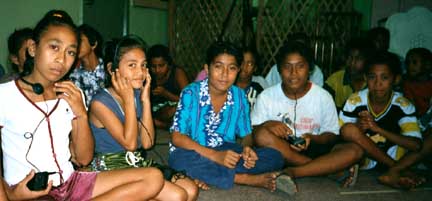
When we arrive, the children are already waiting in the parking lot outside. We find out that another TV taping has just begun that could not be postponed because the host of the show has travelled from the other side of the island and, since he has no phone, there was no way to contact him to move his session. It will be at least 11:30 before we can start recording. I power up all my gear and boot up the G3. Frank helps by setting up phones. Joe comes in and tells us that the kids are so excited that they started getting up at 5:00 AM because they couldn't sleep any longer.
By noon, we have the children come in and we start recording. We enjoyed the songs they sang to us last night so much, we decide to record those first. We had originally intended to use a select group of the best singers (no more than 17), but ALL the kids are so excited and want to participate, so we decide to let all 49 sing on these first songs. We record several takes of three different songs. Technically, everything is going well. The room is live, but not unworkably so. The kids are in good voice and the tuning is good. This is great. The PT system is performing flawlessly, the mics sound good through the Great River preamp, and I am one happy guy.
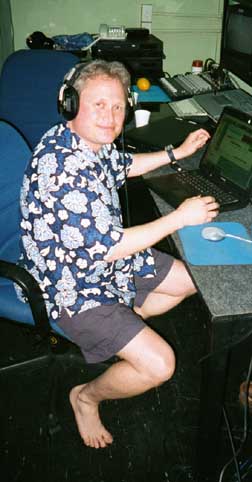
All the kids are performing so well, we decide to use the entire group for the pre-existing track songs, on which they will overdub. We pick 17 key singers and they get the headphones. While not ideal, this is a workable solution. The rest of the kids will follow the conductor and get their pitch center from the key singers wearing headphones. We have two songs to record and we jump right in.
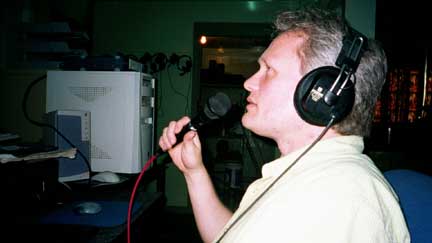
2:30 PM
We've been recording for 2.5 hours now and are almost finished. Some of the kids (ranging in age from 7 to 16) are getting tired, understandably. Joe notices that some of them are losing focus and not paying attention, and decides it's time for a game of "Musical Survivor." The rules are simple: One mistake and you're out. He stands at the front of the group and after each unsuccessful take, he points to several kids. "You, you, you and you," and he motions with his arm for them to leave. Though it seems tough, it's a very powerful incentive to pay attention and within 4 takes we are completely finished. The children are all allowed to leave, but not before I hand out bubble gum that my kids sent with me to give them. But first, we must have a picture.
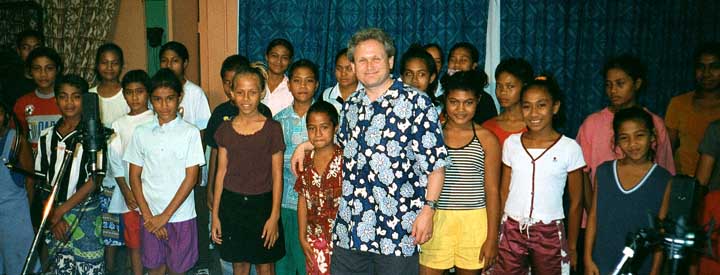
A reporter from the Samoa Observer newspaper is here and he is going to write a story about our visit, so we pose for him as well.
You can read the story from the Samoa Observer here.
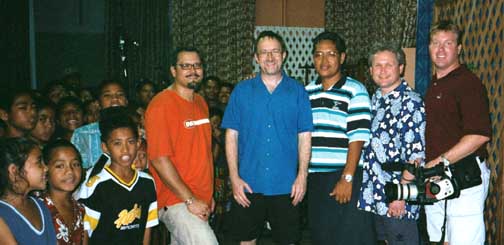
While I make submixes and consolidate soundfiles, Joe drafts Dan and Frank to be the guests on his TV show for his "Mother's Day Special" edition for this coming Sunday. They begin taping while I'm burning CDs with music and time code for the video shoot. It's fascinating to watch, since I am set up right in front of the TV monitors. Joe slips on a jacket over his casual shirt. The lighting is set. The one video guy in the control room has all the cameras (4 total) preset, three of them on the individuals and one wide shot. The show opening credits are cued up on a 1/2" Beta machine and as he presses RECORD on one machine, he puts the opening credits in PLAY. As soon as the credits finish, Joe begins talking with his guests, alternately speaking in Samoan and English, so they can understand and he asks questions and translates as they answer. Twenty nine minutes later, the closing credits are cued and as they fade, he reaches over and hits STOP on both machines. As simple as that.
It goes by so fast that they are done taping the show before I even finish burning the CDs. As I wrap up, the rest of the crew goes to McDonalds for chicken sandwiches. By the time they are back, I have everything packed into the flight cases and we're ready to pack up and leave. It has gone quickly. Just four hours after we walked in the door, we've finished vocals on five songs, made submixes, made duplicate session and audio file copies on two different drives, burned CDs in triplicate and packed up everything.
Now I can relax. My part of this mission has been accomplished successfully and I can take a deep breath and say a prayer of thanks. The adrenaline starts to subside for the first time in three days. Reality sets in. "Where's that chicken sandwich?" It's 3:30 and time for lunch.
We pack the gear back into the van and head off to Papaseea, home of the sliding rocks, which are cascading waterfalls running over smooth rocks in three tiers just like a waterslide. We all go in with the kids who have been there waiting for us for almost two hours. It's beautiful and lush and green. The kids all still want to talk to us and shake our hands. When it's time to go and we climb back up the 100+ steps, the kids grab us around the waist and help us up the stairs, almost carrying us. They are so helpful and eager and friendly and communicative.

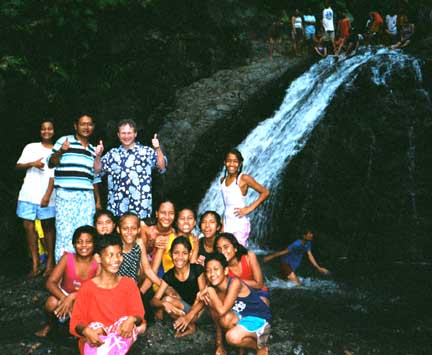
7 PM As we finish a long day, after swimming for just about an hour, the kids change clothes and pile back into the bus and take off toward Samoa's only McDonalds where they are being treated to dinner. This will be the first time to ever eat at McDonalds for all but a handful of the kids. We follow along behind them in the van. As the sun is setting and we drive down the steep road, I hear a sound coming from up ahead. It is the children singing. It is so amazing. After this long, long day to hear them all singing on the bus, it is something I will never forget.
After we get back to the hotel and shower (again) and change, we head to McDonalds to meet them. After they finish eating, they serenade the customers and the kitchen staff with several songs, hand motions and all.

After they finish singing, we say our goodnights to the kids (49 hugs, 49 handshakes, 49 Goodbyes) and they all file back out to the bus. We talk about the schedule for tomorrow for a few moments and then head outside ourselves. When the children see us coming, they all hang their hands and heads out the window to shake our hands again and touch us again and say goodnight again. They are so eager to touch us again, you wouldn't know we saw them last just minutes before. It's touching.
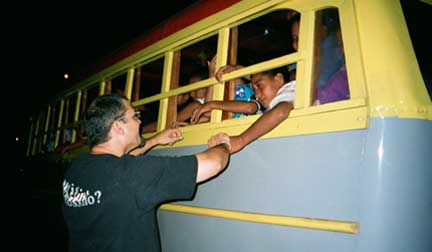
9 PM We finally get back to the hotel and I grab a dinner of fish and chips (made from red snapper) before turning in just before 10PM. It will be a short night because in the morning, we pack everything onto the van and head to the ferry that will take us to the big island of Savaii. We have to leave by 6 AM to be at the ferry by 7 AM. After the events of the day, I drift off without a problem.
On to Day 4.